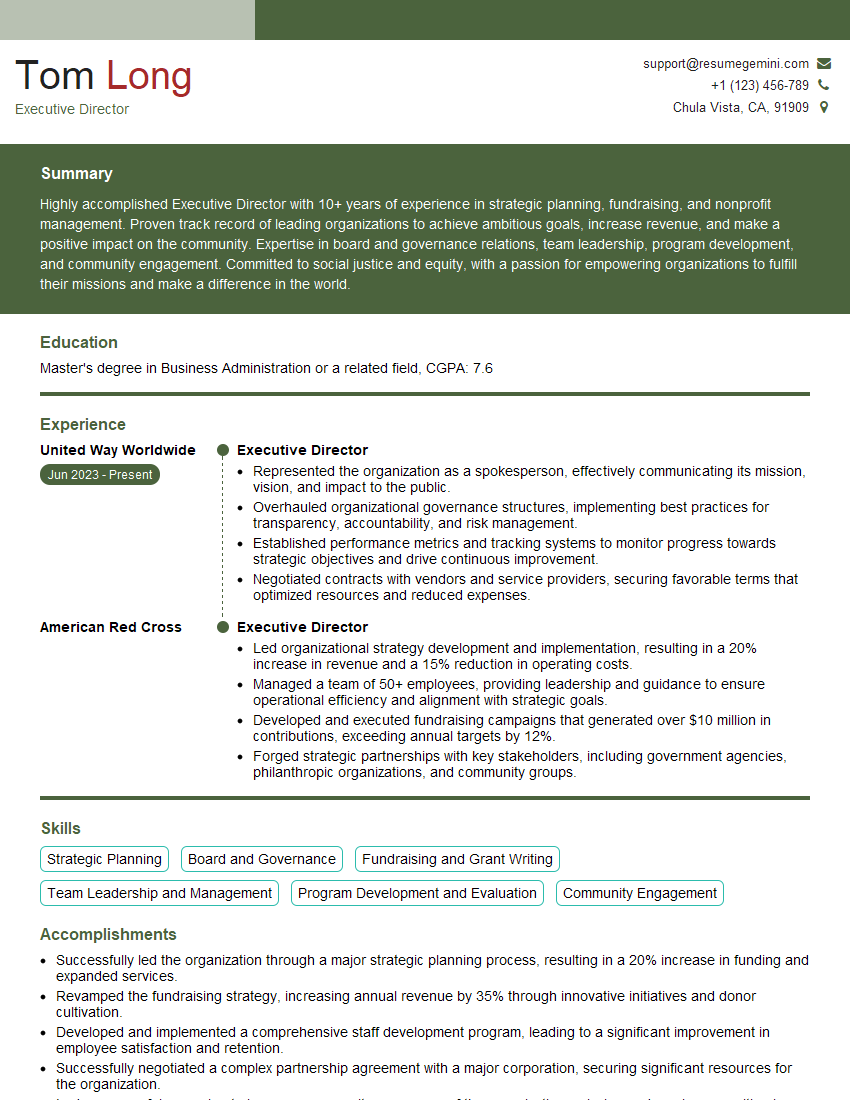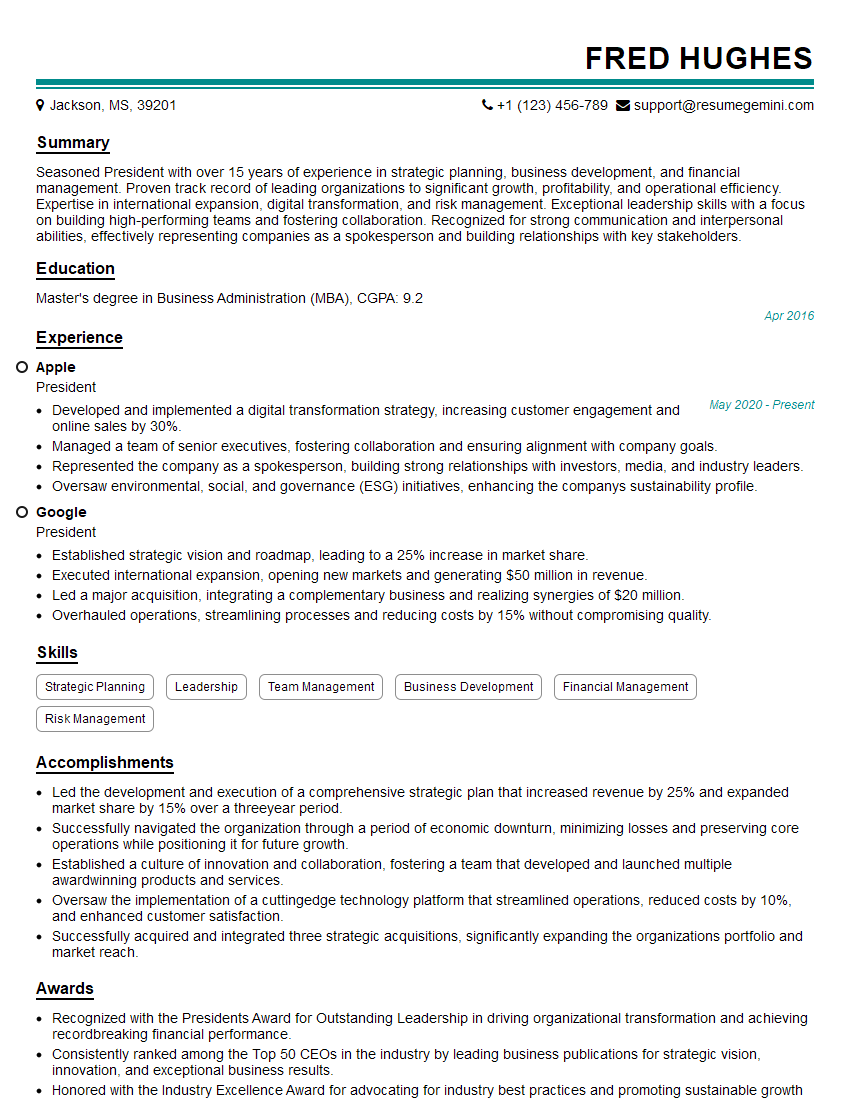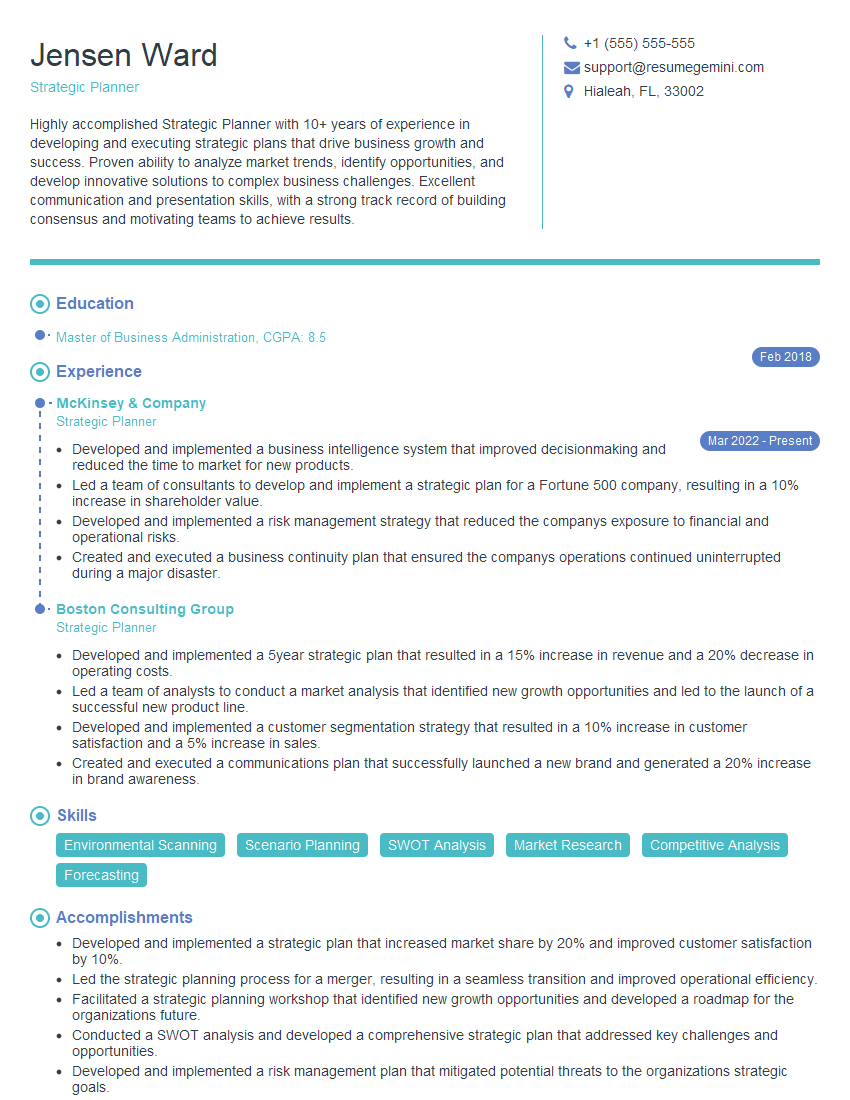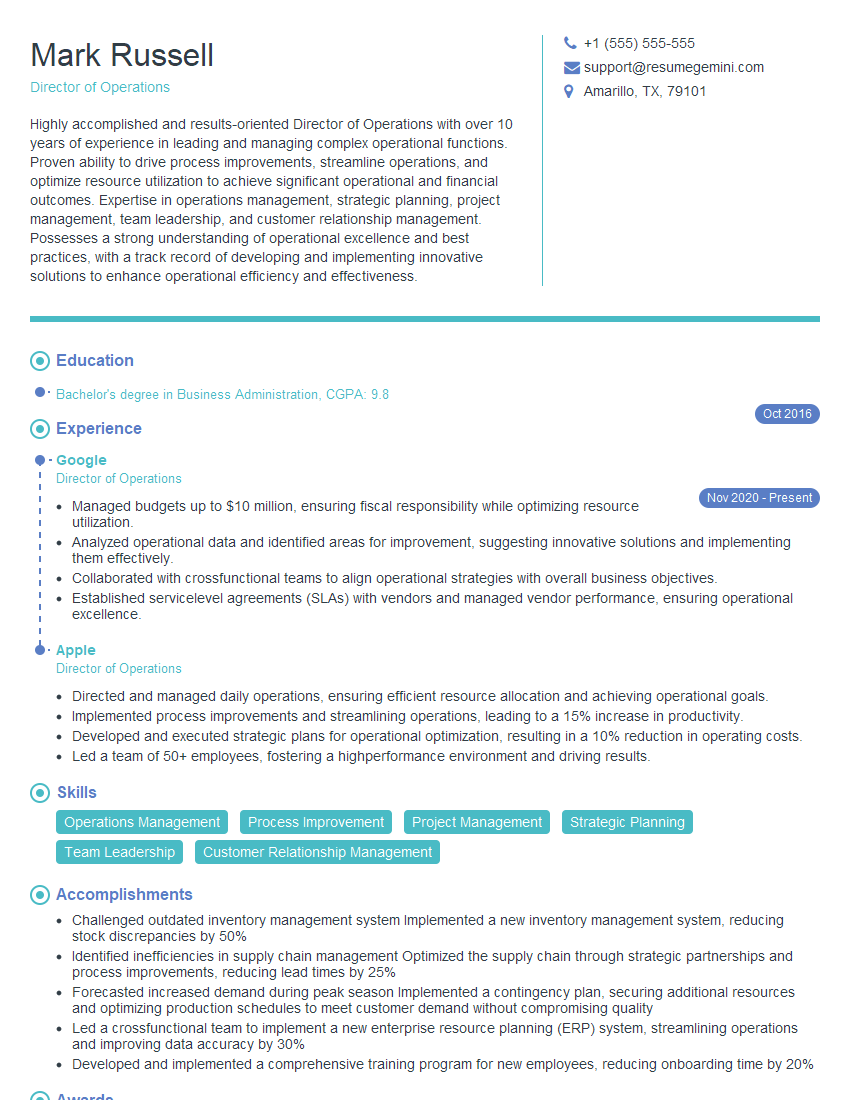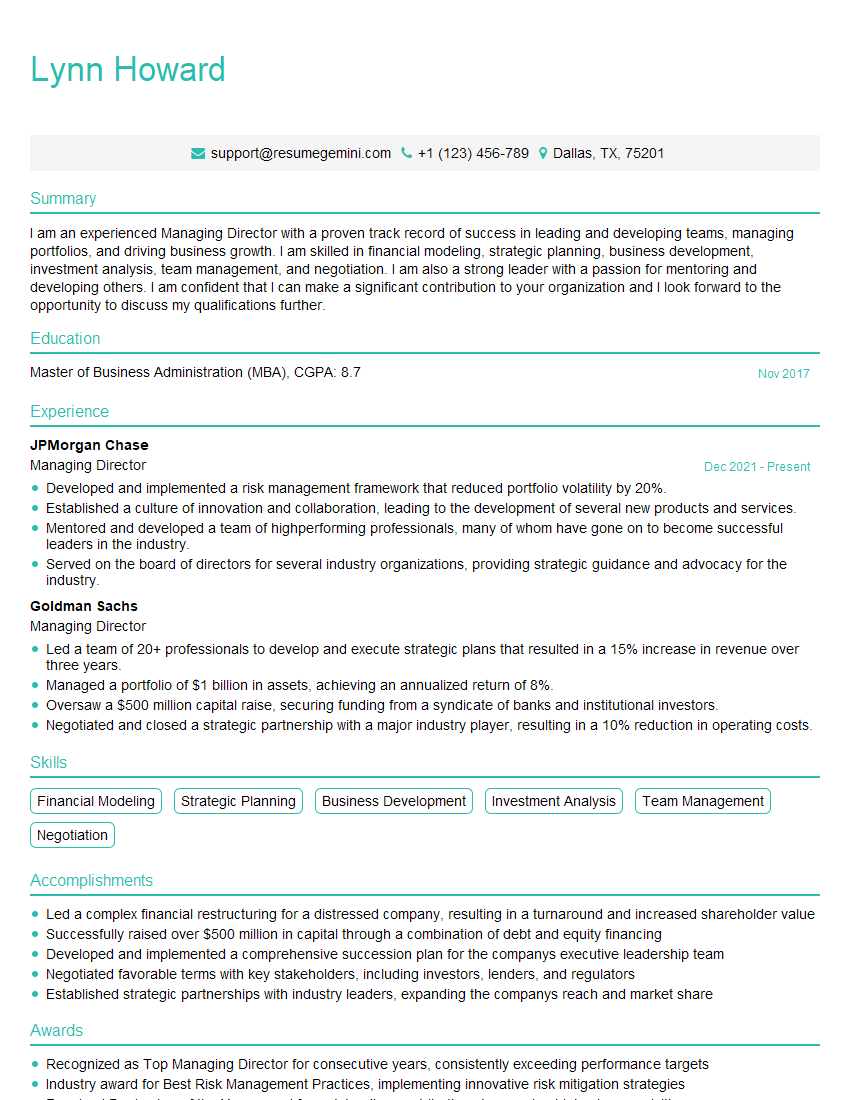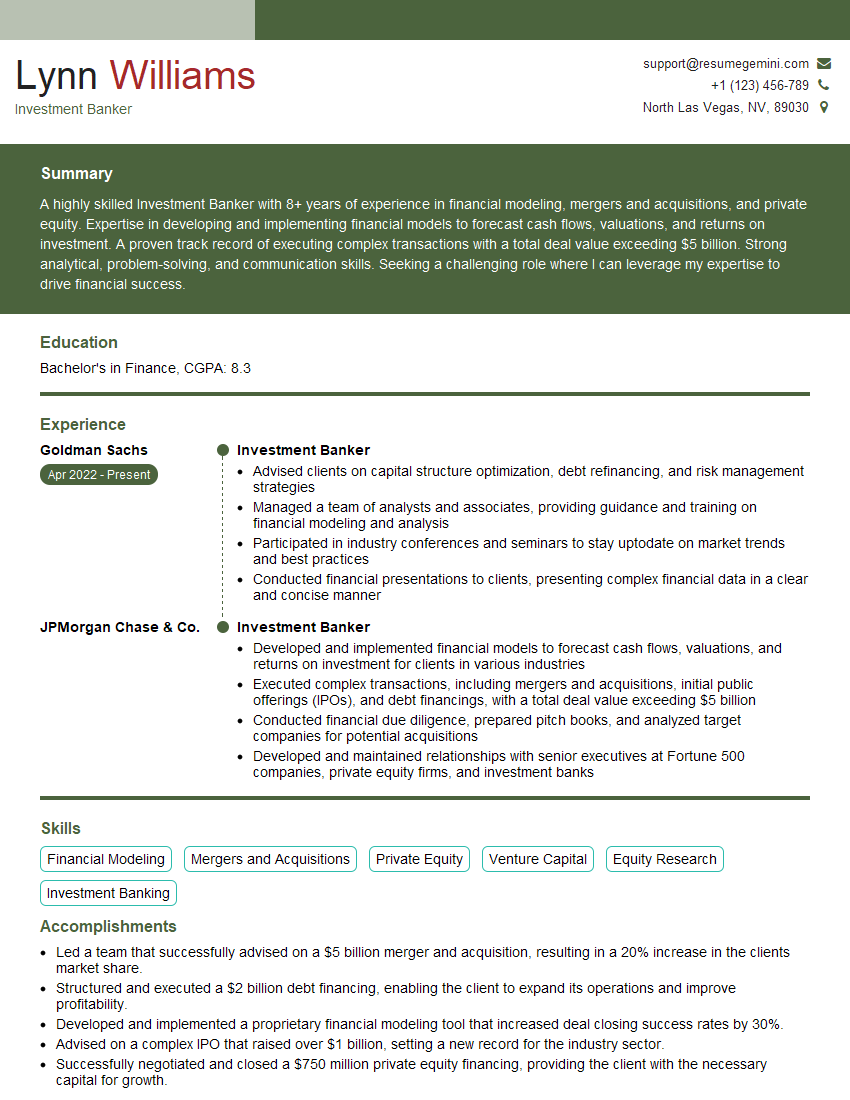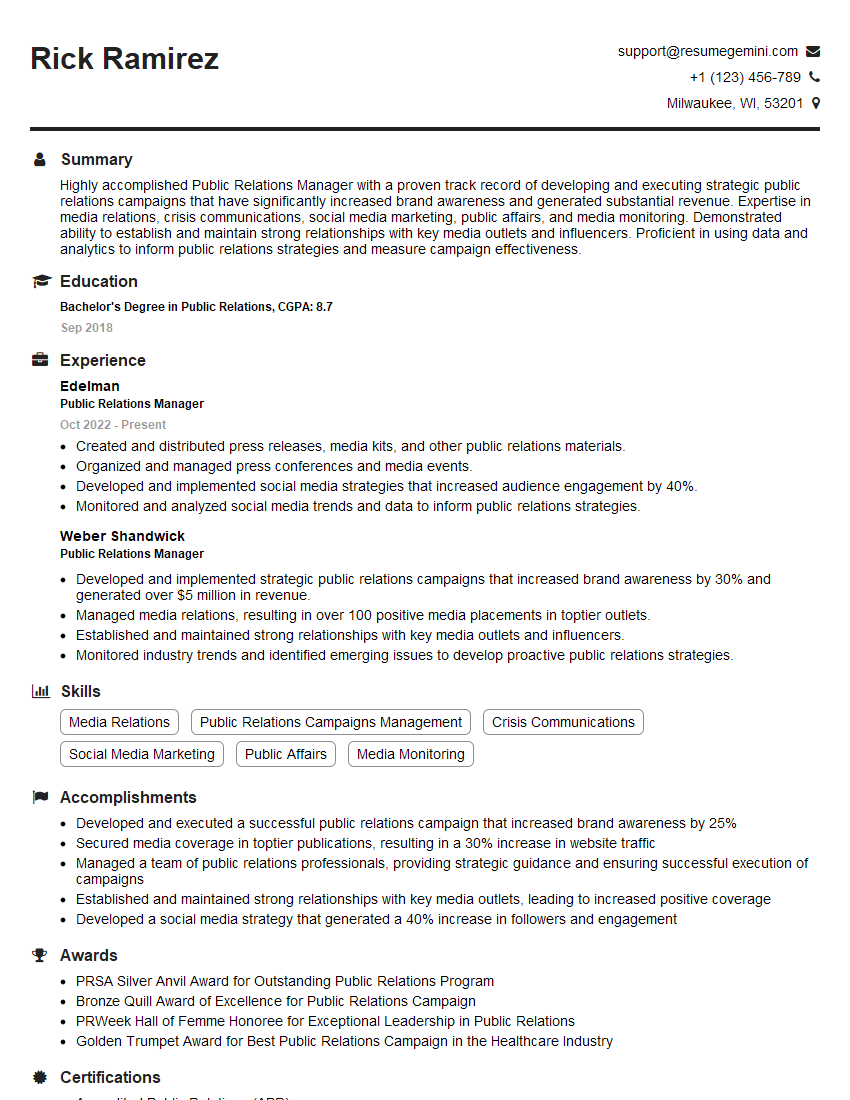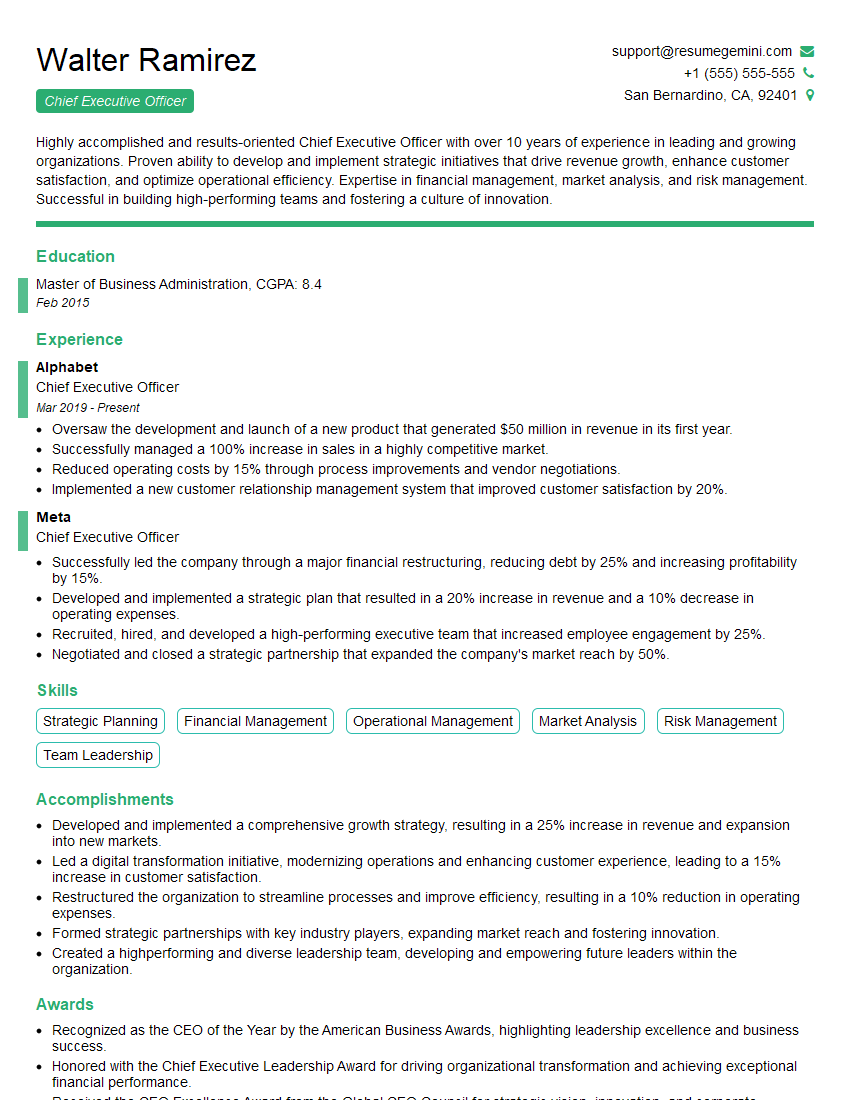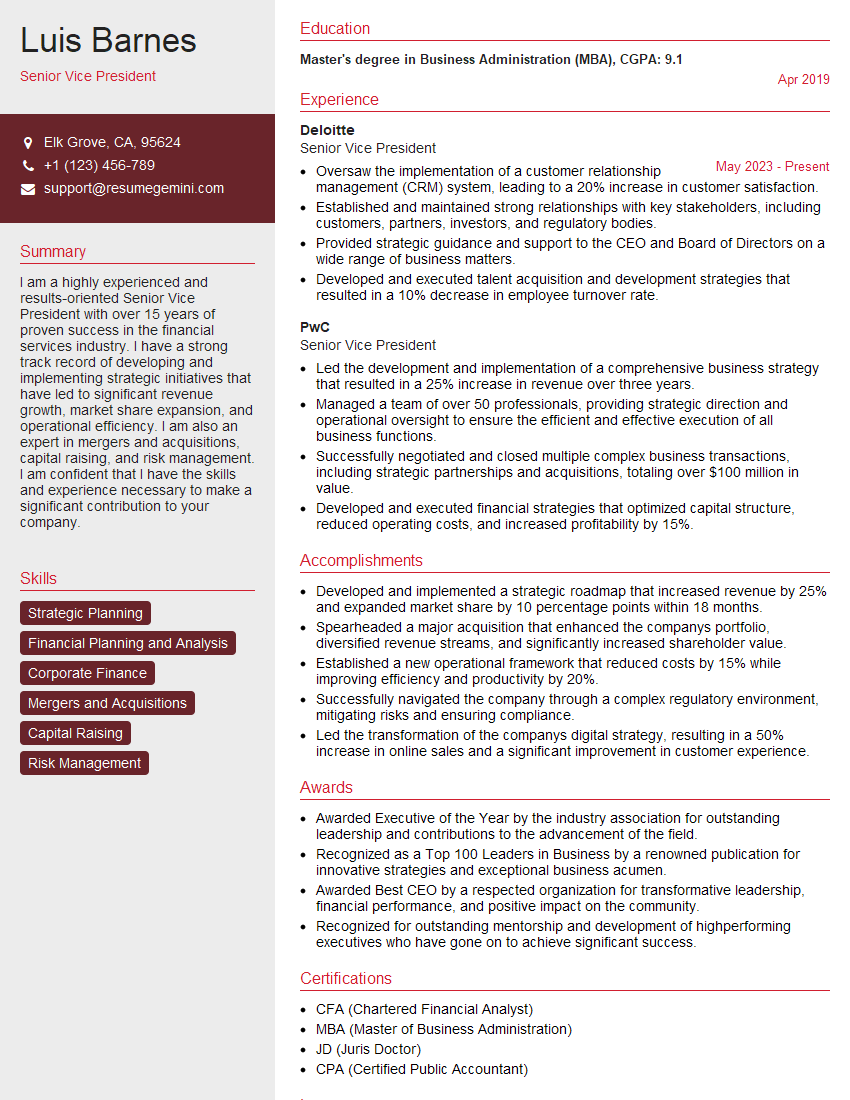Unlock your full potential by mastering the most common Commanding Presence interview questions. This blog offers a deep dive into the critical topics, ensuring you’re not only prepared to answer but to excel. With these insights, you’ll approach your interview with clarity and confidence.
Questions Asked in Commanding Presence Interview
Q 1. Describe a situation where you had to influence a large group.
Influencing large groups requires a blend of strategic communication, empathy, and a clear understanding of the audience’s needs and motivations. It’s not about dominating, but about connecting and inspiring collective action.
For example, during my time leading a cross-functional team to launch a new product, we faced initial resistance from the marketing department who felt the launch timeline was unrealistic. Instead of imposing my view, I organized a series of collaborative workshops. We used a visual timeline to illustrate the critical path and collaboratively identified potential roadblocks. By actively listening to their concerns, acknowledging their expertise, and incorporating their feedback into the revised plan, I successfully built consensus and secured their buy-in. The result was a smoother, more effective product launch.
Q 2. How do you handle disagreements effectively in a professional setting?
Handling disagreements professionally involves focusing on the issue, not the person. It’s about fostering a culture of respectful dialogue and finding common ground. My approach emphasizes active listening, seeking to understand the other person’s perspective before articulating my own.
I often employ a structured approach: First, I clarify the points of contention. Then, I encourage each party to explain their reasoning, ensuring everyone feels heard. Next, I work collaboratively to identify the shared goals and explore solutions that address everyone’s concerns. Finally, we agree on a course of action and establish clear accountability. Even if we can’t completely resolve the disagreement, establishing a framework for future communication helps prevent similar conflicts.
Q 3. How would you present a complex project to a non-technical audience?
Presenting complex projects to non-technical audiences requires simplifying complex information without sacrificing accuracy or detail. The key is to focus on the ‘what’ and ‘why,’ not the ‘how.’
I start by defining the problem the project aims to solve, using relatable analogies and avoiding jargon. I would use visuals like charts, graphs, and infographics to illustrate key concepts and data. A compelling narrative, emphasizing the benefits and impact, helps keep the audience engaged. I also incorporate opportunities for questions and discussion, allowing for clarification and fostering a sense of participation. Think of it like storytelling – you want to create a narrative arc that is both informative and engaging. Instead of technical specifications, I’d focus on the improved efficiency, cost savings, or enhanced customer experience the project delivers.
Q 4. Explain your approach to managing conflict within a team.
Managing team conflict requires a proactive and empathetic approach. Early identification and addressing conflict is crucial. I believe in fostering an environment of open communication where team members feel comfortable expressing their concerns. My approach involves:
- Active Listening: Understanding each individual’s perspective.
- Mediation: Facilitating constructive dialogue between conflicting parties.
- Collaborative Problem-Solving: Working together to find mutually acceptable solutions.
- Clear Expectations: Setting clear guidelines for communication and behavior.
- Follow-up: Monitoring the situation and addressing any recurring issues.
I see conflict as an opportunity for growth and improved team dynamics, provided it is handled constructively.
Q 5. How do you maintain composure under pressure?
Maintaining composure under pressure involves a combination of preparation, self-awareness, and effective coping mechanisms. It’s about managing both your internal and external responses.
I practice mindfulness techniques to center myself, helping me to stay focused and react rationally. Deep breathing exercises help regulate my physiological responses to stress. Prioritization is also key; I focus on the most critical tasks first, avoiding getting overwhelmed by the sheer volume of challenges. Lastly, I actively seek support from my team or mentors when necessary, recognizing that collaboration is key to navigating stressful situations.
Q 6. Describe a time you had to make a difficult decision with limited information.
Making difficult decisions with limited information requires a structured approach. It’s about weighing the available data, assessing potential risks, and making the best possible choice given the circumstances.
In one instance, we had to decide whether to proceed with a major marketing campaign despite uncertain market data. We held a meeting to analyze the incomplete data, identify potential scenarios, and discuss the risks and rewards associated with each. We also factored in the cost of delay and opportunity cost of not launching the campaign. Finally, we selected the option with the least downside risk and greatest potential for success. Although we had incomplete data, our structured approach allowed us to make a well-reasoned and informed decision.
Q 7. How do you inspire confidence in others?
Inspiring confidence in others involves demonstrating competence, empathy, and trust. It’s about fostering a belief in their abilities and in the collective goals.
I achieve this through consistent and clear communication, providing regular feedback, and recognizing individual accomplishments. Actively delegating tasks and providing the necessary support empowers team members and boosts their confidence. Showing genuine interest in their development, providing opportunities for growth, and celebrating their successes fosters a positive and supportive environment where everyone feels valued and capable.
Q 8. How do you handle criticism constructively?
Constructive criticism is a gift, an opportunity for growth. My approach involves a three-step process: Listen, Understand, and Act.
Listen actively and empathetically to the feedback, without interrupting. I focus on understanding the other person’s perspective, even if I don’t agree. I ask clarifying questions to ensure I fully grasp their points. For example, if someone says my presentation lacked impact, I might ask, “Can you give me specific examples of what felt less impactful?” This shows I value their opinion and want to learn.
Understand the underlying message. Is the criticism about a skill gap, a miscommunication, or a different approach? I separate the feedback from the person delivering it; the critique isn’t a personal attack but rather a reflection of the situation.
Act upon the feedback. I consider the validity of the criticism and determine how I can improve. This might involve seeking further training, adjusting my communication style, or refining my approach. I follow up to demonstrate that I’ve taken their feedback seriously. For instance, I might send a thank-you note acknowledging their input and outlining the steps I’ll take.
Q 9. Describe a situation where you had to overcome resistance to your ideas.
In a previous role, I proposed a new project management methodology to streamline our workflow. Initially, many team members resisted, clinging to the familiar, even though the existing system was inefficient and prone to errors. They felt comfortable with the status quo and worried about the learning curve of a new system.
To overcome this resistance, I employed a multi-pronged approach: I started by presenting a compelling case for change, highlighting the concrete benefits – reduced project timelines and improved accuracy. I then addressed their concerns directly, demonstrating how the new methodology would simplify their tasks and provide better support. I also facilitated a series of workshops where team members could collaboratively explore the new system, providing hands-on training and answering their questions. This collaborative approach fostered buy-in and allowed them to see the practical advantages firsthand. The gradual implementation and continuous feedback loops further eased the transition, eventually leading to widespread acceptance and significant productivity gains.
Q 10. How do you build rapport with diverse individuals?
Building rapport with diverse individuals requires genuine curiosity and empathy. I begin by actively listening to understand their perspectives, backgrounds, and communication styles. I avoid making assumptions and strive to create a safe space for open dialogue.
I demonstrate respect by using inclusive language, acknowledging cultural differences, and adapting my communication style accordingly. For instance, I might adjust my pace and tone of speech depending on the individual’s communication preferences. I also make an effort to find common ground, focusing on shared goals and values, fostering a sense of connection and understanding. I believe that finding points of connection, however small, can break down barriers and facilitate effective communication and collaboration.
Q 11. How do you delegate tasks effectively?
Effective delegation involves assigning tasks based on individual strengths and skills. I begin by clearly defining the task, outlining the desired outcome, and setting realistic deadlines. I also provide the necessary resources and support, ensuring the individual has everything they need to succeed.
Crucially, I empower them by granting autonomy and trusting them to manage their work. Regular check-ins are important to offer guidance and support without micromanaging. I actively listen to their feedback and address any concerns or roadblocks. This collaborative approach builds trust and enhances ownership, leading to improved results and team morale. For example, if I delegate a marketing campaign to a team member, I ensure they have access to the relevant data, design software, and marketing budget, and we have regular meetings to track progress and address issues promptly.
Q 12. Describe your experience in leading and motivating a team.
Leading and motivating a team is about fostering a collaborative and supportive environment. I believe in leading by example, setting high standards, and demonstrating a strong work ethic. I encourage open communication, creating a safe space for team members to share ideas and concerns.
I regularly recognize and appreciate individual and team accomplishments, celebrating successes both big and small. I also provide constructive feedback and support, focusing on individual growth and development. I delegate effectively to empower team members and foster a sense of ownership. In a previous team leadership role, we adopted a system of regular team huddles where we discussed progress, shared challenges, and offered each other support. This fostered camaraderie and created a more collaborative and efficient team environment.
Q 13. How do you ensure your communication is clear and concise?
Clear and concise communication is essential for effective leadership. I achieve this by carefully planning my messages beforehand. I focus on conveying only the necessary information, avoiding jargon or unnecessary details. I use a structured approach, ensuring the message is logical and easy to follow.
I utilize visual aids, such as presentations or diagrams, to enhance understanding. After delivering the message, I actively seek feedback to ensure it was understood as intended. For example, instead of saying “We need to improve our efficiency in the workflow,” I would say, “To improve workflow efficiency, we’ll implement a new project management software next week.”
Q 14. How do you adapt your communication style to different audiences?
Adapting communication style is crucial for effective interaction across different audiences. I tailor my communication to the audience’s level of understanding, their background, and their communication preferences. For example, I would use more technical jargon when speaking to a team of engineers, but I would simplify my language when talking to a group of non-technical stakeholders.
I also adapt my communication style based on the context and the desired outcome. I might use a formal tone for a presentation to senior management, but a more casual and conversational approach for a team meeting. Active listening and observing nonverbal cues are essential for understanding audience needs and adjusting communication accordingly.
Q 15. How do you handle difficult questions during presentations?
Handling difficult questions during presentations requires a combination of preparation, composure, and skillful communication. The key is to never appear flustered. Instead, I employ a three-step approach:
- Acknowledge and Rephrase: I begin by acknowledging the question, perhaps saying something like, “That’s a great question, and I appreciate you raising it.” Then, I rephrase the question to ensure I understand it completely and to buy myself a few seconds to formulate a thoughtful response. This demonstrates respect and ensures clarity.
- Structured Response: I structure my answer logically, even if I don’t have a readily available answer. This might involve breaking down a complex question into smaller, more manageable parts. If I don’t know the precise answer, I will say so honestly, but frame it positively. For instance, “That’s a complex issue, and while I don’t have the exact data at my fingertips, I can tell you…” and then offer what I *do* know, directing the questioner to resources for the rest.
- Graceful Exit (if necessary): If a question veers off-topic or is disruptive, I gracefully steer the conversation back on track. I might say, “That’s an interesting point, but to stay within the scope of today’s presentation…” or offer to discuss it further offline.
For example, if I were presenting on project management and asked about a specific software I wasn’t familiar with, I would acknowledge the question, state I’m not familiar with that *specific* software, but would highlight my experience with similar project management tools and outline my proficiency in adapting to new software based on the core principles of project management.
Career Expert Tips:
- Ace those interviews! Prepare effectively by reviewing the Top 50 Most Common Interview Questions on ResumeGemini.
- Navigate your job search with confidence! Explore a wide range of Career Tips on ResumeGemini. Learn about common challenges and recommendations to overcome them.
- Craft the perfect resume! Master the Art of Resume Writing with ResumeGemini’s guide. Showcase your unique qualifications and achievements effectively.
- Don’t miss out on holiday savings! Build your dream resume with ResumeGemini’s ATS optimized templates.
Q 16. Describe a time you had to give feedback to a colleague.
Giving constructive feedback is a crucial aspect of collaboration. Recently, a colleague, let’s call him Mark, was struggling to meet deadlines on a crucial design project. Instead of directly criticizing, I approached the situation strategically.
- Private Setting: I scheduled a one-on-one meeting with Mark in a private setting to ensure he felt comfortable and safe.
- Focus on Behavior, Not Personality: I focused on the specific behavior (missing deadlines) rather than attacking his character. I said something like, “Mark, I’ve noticed the deadlines for the design project have been slightly delayed.”
- Sandwich Method: I used the “sandwich method,” starting with positive reinforcement (“I really appreciate your creativity and innovative ideas on this project”), then addressing the concern (“However, the delays are impacting the overall timeline”), and ending with encouragement and support (“I’m confident you can overcome this. Perhaps we can brainstorm some strategies together to manage your time more effectively?”).
- Collaborative Solutions: Together, we identified potential root causes for the missed deadlines (e.g., lack of prioritization, unforeseen technical difficulties) and collaboratively developed solutions. We established clear goals and timelines going forward.
The result was a more productive workflow and a strengthened professional relationship with Mark. He appreciated the honest, constructive feedback and the collaborative problem-solving approach.
Q 17. How do you prioritize tasks and manage your time effectively?
Effective time management and task prioritization are critical for maximizing productivity. I use a combination of techniques:
- Prioritization Matrix (Eisenhower Matrix): I categorize tasks based on urgency and importance (Urgent/Important, Important/Not Urgent, Urgent/Not Important, Not Urgent/Not Important). This helps me focus my energy on high-impact activities.
- Time Blocking: I allocate specific time blocks in my day for particular tasks. This helps maintain focus and prevents task-switching.
- Task Batching: I group similar tasks together to minimize context switching and improve efficiency. For example, I’ll respond to all emails at once rather than checking them sporadically throughout the day.
- Regular Review and Adjustment: I regularly review my schedule and adjust priorities as needed, based on unforeseen circumstances or changing deadlines.
- Delegation: Where possible, I delegate tasks to others to free up my time for higher-priority activities. This requires clear communication and effective delegation strategies.
For example, if I have a presentation to prepare, client meetings to attend, and emails to respond to, I’d prioritize the presentation first (important and time-sensitive), then schedule blocks of time for client meetings, and batch my email responses in between to maximize my efficiency.
Q 18. How do you use your body language to convey confidence?
Body language is a powerful tool for conveying confidence. It’s non-verbal communication that speaks volumes. Here are key aspects:
- Posture: Maintain an upright, but relaxed posture. Avoid slouching or hunching. Good posture projects confidence and self-assurance.
- Eye Contact: Make consistent, yet natural, eye contact with your audience. Avoid staring intensely, but engage individuals throughout the room. This establishes a connection and conveys trust.
- Gestures: Use deliberate, controlled hand gestures to emphasize key points. Avoid excessive or nervous fidgeting. Natural gestures enhance communication.
- Facial Expressions: Maintain a calm and approachable expression. A genuine smile can go a long way in creating rapport.
- Movement: Move purposefully and with intention. Avoid pacing nervously or fidgeting. Controlled movement showcases self-possession.
For example, when delivering a presentation, I ensure I stand tall, make eye contact with different members of the audience, use open and welcoming hand gestures, and maintain a friendly and reassuring smile. These actions together communicate my confidence and expertise on the subject matter.
Q 19. How do you manage your stress levels during high-pressure situations?
Managing stress in high-pressure situations is vital for maintaining performance and well-being. I employ several strategies:
- Preparation: Thorough preparation significantly reduces anxiety. Knowing my material well and anticipating potential challenges helps me feel more confident.
- Mindfulness and Deep Breathing: I utilize mindfulness techniques and deep breathing exercises to calm my nervous system in stressful moments. A few deep breaths can make a significant difference.
- Positive Self-Talk: I engage in positive self-talk, focusing on my strengths and past successes to boost my confidence.
- Physical Activity: Regular exercise and physical activity are essential for managing stress levels. It helps to release endorphins and improve overall well-being.
- Time Management: Effective time management reduces pressure by ensuring I’m not overwhelmed with too many tasks.
For example, before an important presentation, I practice my delivery multiple times, visualize a successful presentation, and engage in deep breathing exercises to calm my nerves. This approach helps me manage the stress and enables me to perform at my best.
Q 20. Describe a situation where you had to negotiate a favorable outcome.
Negotiation is a frequent part of my professional life. In one instance, our team was facing a significant budget shortfall on a critical project. The initial budget allocation was insufficient to meet our needs. I negotiated with the stakeholders involved to secure additional funding.
- Preparation: I thoroughly researched the project’s value, the potential impact of insufficient funding, and alternative cost-saving measures.
- Collaboration: I approached the negotiation as a collaborative process, seeking common ground with the stakeholders. I presented a clear, concise rationale for the additional funding.
- Value Proposition: I highlighted the project’s potential ROI and the positive impact it would have on the organization. I provided concrete data and evidence to support my case.
- Compromise: I was willing to compromise, offering alternative solutions to reduce costs where appropriate.
- Win-Win Outcome: The negotiation resulted in a win-win scenario. We secured the necessary funding, and the stakeholders felt confident that their resources were being utilized effectively.
This experience taught me the importance of preparation, collaborative communication, and a willingness to compromise in order to achieve favorable outcomes in negotiations.
Q 21. How do you make decisions decisively?
Decisive decision-making is a crucial skill. I approach it systematically:
- Gather Information: I gather all relevant information and data before making a decision. This ensures I’m making an informed choice.
- Analyze Options: I analyze the potential pros and cons of each option, considering potential risks and rewards.
- Set Criteria: I establish clear criteria for evaluating the options. This helps ensure objectivity and consistency.
- Time Constraints: I recognize the importance of time constraints. While thoroughness is important, procrastination can be detrimental. I set realistic deadlines for decision-making.
- Trust Intuition: After careful analysis, I trust my intuition. Experience plays a significant role in making informed judgments.
- Review and Adjust: After making a decision, I review its effectiveness and make adjustments as needed. Continuous improvement is key.
For example, when choosing between two potential software solutions, I’d gather data on cost, features, user reviews, and scalability. Then I’d weigh these factors against my pre-determined criteria and trust my experience in selecting the most suitable option. Importantly, I would allow for flexibility and would be open to reconsidering the decision if new data indicated a better alternative.
Q 22. How do you build consensus among team members?
Building consensus isn’t about forcing agreement; it’s about fostering collaboration and shared understanding. It requires a multi-faceted approach.
- Active Listening: Truly hear everyone’s perspectives, asking clarifying questions to ensure you grasp their points. Avoid interrupting.
- Empathetic Communication: Acknowledge and validate each team member’s concerns, even if you don’t agree with them. Show that you understand their viewpoints.
- Collaborative Problem-Solving: Frame discussions around finding solutions together, rather than winning arguments. Encourage brainstorming and exploring various options.
- Transparency and Openness: Share relevant information openly and honestly. This builds trust, crucial for effective consensus-building.
- Compromise and Negotiation: Be willing to compromise and negotiate. Finding a solution that satisfies everyone may not always be possible, but aiming for a mutually acceptable outcome is key.
Example: In a recent project, we had differing opinions on the best approach to a challenging technical problem. Instead of imposing my solution, I facilitated a discussion, allowing each team member to present their ideas. We then collaboratively evaluated each approach, weighing the pros and cons. This led to a hybrid solution that incorporated the best aspects of each suggestion, resulting in higher team satisfaction and a more robust outcome.
Q 23. How do you remain calm and assertive in challenging conversations?
Maintaining calm and assertiveness during challenging conversations is crucial for effective communication. It’s about self-regulation and clear communication.
- Deep Breathing Techniques: Before engaging, take a few deep breaths to center yourself and regulate your emotional response.
- Active Listening: Pay close attention to what the other person is saying, without interrupting. This helps to de-escalate tension.
- Calm and Measured Tone: Speak in a calm and measured tone, avoiding accusatory or aggressive language. Use ‘I’ statements to express your perspective without blaming.
- Clear and Concise Communication: Express your points clearly and concisely, avoiding ambiguity.
- Setting Boundaries: If the conversation becomes unproductive or disrespectful, politely but firmly set boundaries. For example, ‘I appreciate your point, but let’s stick to the topic at hand.’
Example: During a tense budget meeting, a stakeholder voiced strong objections to my proposed allocation. Instead of reacting defensively, I actively listened to their concerns, acknowledging their frustration. I then calmly explained the rationale behind my decisions, providing data to support my approach. Through clear and respectful dialogue, we reached a mutually acceptable compromise.
Q 24. How do you demonstrate empathy while maintaining your authority?
Demonstrating empathy while maintaining authority isn’t contradictory; it’s a powerful combination. It’s about understanding others’ feelings while leading decisively.
- Active Listening and Validation: Actively listen to understand their perspective and validate their feelings, even if you don’t necessarily agree.
- Empathetic Language: Use language that shows understanding and concern. For example, ‘I understand this is frustrating,’ or ‘I can see why you feel that way.’
- Clear Expectations: Ensure your expectations are clear and unambiguous, even when expressing empathy. This prevents confusion and maintains authority.
- Fair and Consistent Decision-Making: Make fair and consistent decisions based on objective criteria, even if it means disappointing someone. Explain your reasoning transparently.
- Seeking Input While Maintaining Final Authority: Show that you value others’ input while still making the final call, ensuring accountability.
Example: A team member was struggling with a project deadline. I acknowledged their stress and offered support, but also reinforced the importance of the deadline and collaboratively worked on strategies to help them meet it. The empathy built trust, and my assertive approach ensured the project stayed on track.
Q 25. Describe a time you had to deal with a difficult stakeholder.
I once worked with a stakeholder who was highly resistant to change and frequently voiced their disapproval of our team’s progress.
My approach: I began by scheduling individual meetings to understand their concerns. I actively listened, validating their feelings without agreeing with their objections. I then presented data and progress reports to demonstrate the value of our work. I also proactively sought their input on specific elements of the project, giving them a sense of ownership. Slowly, their resistance lessened. We ultimately built a more constructive relationship, and the project was completed successfully.
Key takeaway: Understanding the root of the conflict is vital. Sometimes, it’s not about the project itself, but about underlying anxieties or perceived threats. Addressing those concerns directly can often resolve seemingly intractable conflicts.
Q 26. How do you proactively identify and address potential problems?
Proactive problem identification involves anticipating potential issues before they arise.
- Regular Check-ins: Conduct regular check-ins with team members and stakeholders to monitor progress and identify early warning signs.
- Risk Assessment: Develop a comprehensive risk assessment process to identify potential problems and plan mitigation strategies.
- Data Analysis: Analyze data to identify trends and patterns that might indicate potential problems.
- Scenario Planning: Conduct scenario planning exercises to anticipate various possibilities and develop contingency plans.
- Open Communication: Foster an open communication environment where team members feel comfortable raising concerns.
Example: During a new software launch, I anticipated potential server overload. Based on previous launches and projected usage, I implemented proactive scaling strategies which minimized performance issues and ensured a smooth launch. This prevented a major disruption and showcased proactive problem-solving.
Q 27. How do you utilize active listening skills in professional settings?
Active listening involves fully concentrating on what the speaker is saying, both verbally and nonverbally. It’s more than just hearing; it’s understanding.
- Nonverbal Cues: Pay close attention to nonverbal cues such as body language, facial expressions, and tone of voice.
- Paraphrasing and Summarizing: Regularly paraphrase and summarize what the speaker has said to ensure you’re understanding them correctly.
- Asking Clarifying Questions: Ask clarifying questions to gain a deeper understanding of their perspective.
- Empathetic Responses: Respond in a way that shows you understand and care about what the speaker is saying.
- Avoiding Interruptions: Avoid interrupting the speaker. Let them fully express their thoughts before responding.
Example: In a client meeting, I actively listened to their concerns about a delayed project. By paraphrasing their points and asking clarifying questions, I demonstrated understanding and built trust, allowing for a productive discussion leading to a mutually acceptable solution.
Q 28. How do you ensure accountability within a team?
Ensuring accountability within a team requires clear expectations, transparent communication, and consistent follow-up.
- Clear Roles and Responsibilities: Clearly define roles and responsibilities for each team member.
- Setting Measurable Goals: Set measurable goals and deadlines to track progress and identify areas needing improvement.
- Regular Progress Reviews: Conduct regular progress reviews to track progress, provide feedback, and address any issues.
- Open and Honest Feedback: Provide open and honest feedback, both positive and constructive.
- Consequences for Missed Deadlines: Establish clear consequences for missed deadlines or unmet expectations, ensuring fairness and transparency.
Example: By using a project management tool with clear task assignments and deadlines, combined with weekly progress meetings and regular feedback, we maintained team accountability and successfully delivered our project on time and within budget.
Key Topics to Learn for Commanding Presence Interview
- Self-Awareness and Confidence: Understanding your strengths and weaknesses, projecting confidence through posture and communication, and effectively managing nerves.
- Effective Communication: Articulating your thoughts clearly and concisely, active listening, adapting your communication style to different audiences, and handling challenging questions with grace.
- Nonverbal Communication: Mastering body language, maintaining eye contact, using appropriate gestures, and projecting an image of professionalism and competence.
- Storytelling and Narrative: Structuring your experiences into compelling narratives that highlight your skills and achievements, showcasing impact and results.
- Presence and Influence: Projecting authority and credibility without being aggressive, commanding attention respectfully, and demonstrating leadership potential.
- Questioning and Engagement: Asking insightful questions to demonstrate your interest and understanding, actively participating in the conversation, and contributing valuable insights.
- Resilience and Adaptability: Handling unexpected questions or challenges gracefully, maintaining composure under pressure, and demonstrating a positive attitude.
Next Steps
Mastering commanding presence is crucial for career advancement. It allows you to confidently showcase your skills and achievements, leaving a lasting positive impression on interviewers and ultimately increasing your chances of securing your desired role. To further strengthen your candidacy, creating an ATS-friendly resume is essential for getting your application noticed. ResumeGemini is a trusted resource to help you build a professional and impactful resume that highlights your commanding presence. Examples of resumes tailored to showcase commanding presence are available to guide you. Invest the time in crafting a strong resume – it’s your first impression!
Explore more articles
Users Rating of Our Blogs
Share Your Experience
We value your feedback! Please rate our content and share your thoughts (optional).
